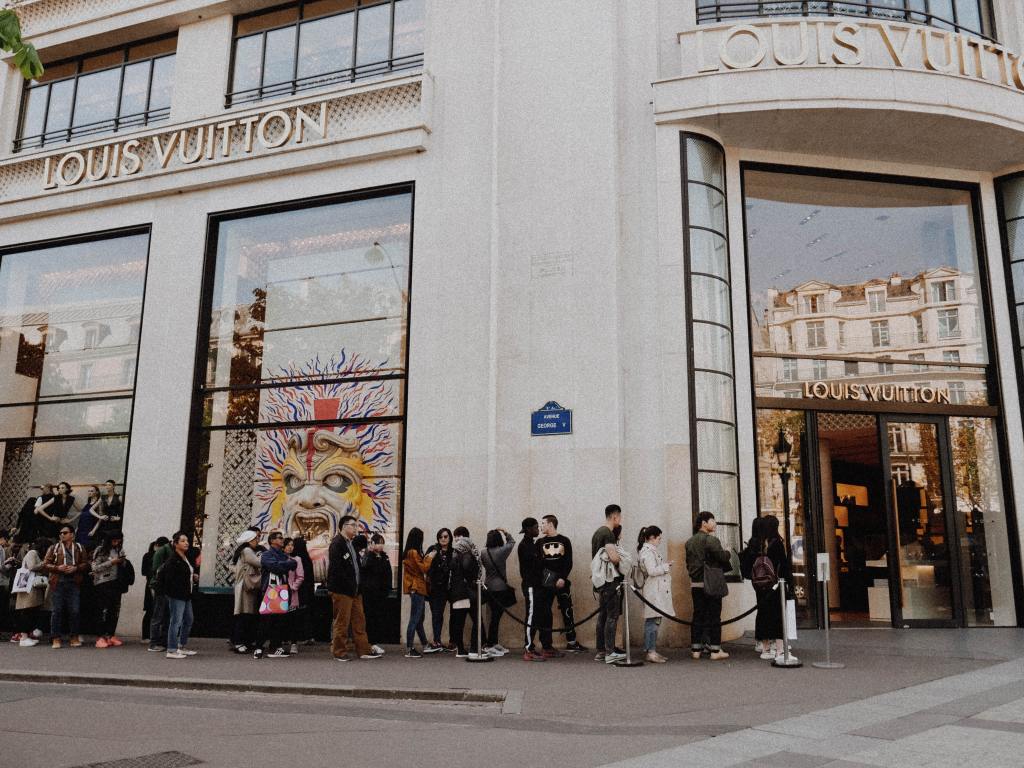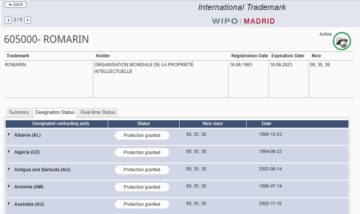The General Court of the European Union has ruled in the case T‑275/21 Louis Vuitton Malletier v Norbert Wisniewski, which focuses our attention on the proof of secondary distinctiveness.
The dispute concerns the following international figurative mark with a designation of the EU for class 18 – ‘Boxes of leather or imitation leather, trunks, suitcases, traveling sets (leatherware), traveling bags, luggage, garment bags for travel, hat boxes of leather, vanity cases (not fitted), toiletry bags (empty), backpacks, satchels, handbags, beach bags, shopping bags, shoulder-strap bags, carrier bags, shoulder bags, waist bags, purses, attaché cases, briefcases (leatherware), school bags, document holders, clutch bags, wallets, change purses, key cases, card cases (wallets), umbrellas, sunshades:
Against this mark, an application for invalidity was filed based on the assumption of a lack of inherent distinctiveness.
The EUIPO confirmed the invalidation but in the appeal, the decision was remitted to the Fifth Board of Appeal because of some errors. The Board confirmed the invalidation again and this decision was appealed once again.
Now the General Court upheld the EUIPO position finding the lack of distinctiveness of the mark. When it comes to the evidence for acquired distinctive character through use in the EU, submitted by Louis Vuitton, the Court considered them sufficient for some parts of the EU but not for the entire Union. There was not enough evidence for the mark’s awareness in Bulgaria, Estonia, Lithuania, Latvia, Slovakia, and Slovenia, together with Malta
That was a problem for Louis Vuitton because in order to rely on an acquired distinctiveness in the EU the trademark owner has to prove it for the territory of the entire EU, all Member States.
Louis Vuitton claimed that because their mark is popular in many EU countries, including neighboring to the above-mentioned, consumers in all countries are aware of the mark and its reputation. The Court dismissed this approach.
First, the applicant submits that the analysis, in the contested decision, of distinctive character acquired through use of the contested mark is detached from reality, since it ignores the fact that, throughout the European Union, consumers engage in homogeneous behaviour as regards luxury brands, particularly because they travel and use the internet regularly. However, that argument is too general in nature. Given that the burden of proof of the acquisition of distinctive character through use lies with the proprietor of the mark, it is for the proprietor to adduce specific and substantiated evidence for that purpose (see paragraph 20 above).
Secondly, the applicant claims, in essence, that the distinctive character acquired through use of the contested mark in the Member States concerned is corroborated by the geographical and cultural proximity of Latvia and Lithuania to Poland and Sweden, on the one hand, and of Bulgaria, Slovakia and Slovenia to Romania, on the other hand, it being noted that, according to the applicant, the mark had acquired a distinctive character with consumers in Poland, Sweden and Romania.
However, that argument is not at all substantiated. The applicant has not adduced any evidence to show that, due to their geographical and cultural proximity, the relevant Latvian and Lithuanian public had sufficient knowledge of the goods or services on the Polish and Swedish markets, or that the relevant Bulgarian, Slovenian or Slovakian public had such knowledge of the Romanian market, within the meaning of the case-law cited in paragraph 27 above. Nor has the applicant demonstrated, or even alleged, that it had grouped those Member States in the same distribution network or that it had treated them, particularly from the marketing strategy perspective, as if they constituted one and the same market.
Thirdly, nor may the applicant’s argument that the distinctive character acquired through use of the contested mark in Bulgaria, Slovakia and Slovenia is corroborated by the fact that those Member States are ‘in a strategic area for the circulation of counterfeit products in Eastern Europe’ be upheld due to its being too general in nature.
.wordads-ad-wrapper {display:none;font: normal 11px Arial, sans-serif;letter-spacing: 1px;text-decoration: none;width: 100%;margin: 25px auto;padding: 0;}.wordads-ad-title {margin-bottom: 5px;}.wordads-ad-controls {margin-top: 5px;text-align: right;}.wordads-ad-controls span {cursor: pointer;}.wordads-ad {width: fit-content;margin: 0 auto;}
- SEO Powered Content & PR Distribution. Get Amplified Today.
- Platoblockchain. Web3 Metaverse Intelligence. Knowledge Amplified. Access Here.
- Source: https://intellectualpropertyplanet.wordpress.com/2023/03/22/louis-vuitton-failed-to-prove-the-distinctiveness-of-its-figurative-mark-in-the-eu/
- :is
- 1
- a
- above
- According
- acquired
- acquisition
- All
- alleged
- analysis
- and
- appeal
- Application
- approach
- ARE
- AREA
- argument
- AS
- assumption
- At
- attention
- auto
- awareness
- bags
- based
- BE
- Beach
- because
- being
- board
- boxes
- brands
- Bulgaria
- Bulgarian
- burden
- by
- card
- case
- cases
- change
- character
- Circulation
- cited
- claimed
- claims
- class
- concerned
- Concerns
- CONFIRMED
- considered
- Consumers
- Counterfeit
- countries
- Court
- cultural
- decision
- demonstrated
- designation
- Dispute
- distribution
- document
- download
- eastern
- engage
- enough
- Entire
- Errors
- essence
- estonia
- EU
- Europa
- European
- european union
- Even
- evidence
- Failed
- Files
- finding
- focuses
- following
- For
- from
- General
- geographical
- given
- goods
- hand
- hat
- holders
- However
- HTTPS
- in
- Including
- inherent
- International
- Internet
- IT
- ITS
- jpg
- Key
- knowledge
- Lack
- LATVIA
- Latvian
- Lithuania
- Louis
- Luxury
- many
- Margin
- mark
- Mark’s
- Market
- Marketing
- Markets
- max-width
- meaning
- member
- Nature
- network
- normal
- noted
- of
- on
- ONE
- order
- Other
- owner
- particularly
- parts
- perspective
- plato
- Plato Data Intelligence
- PlatoData
- Poland
- Polish
- Popular
- position
- Problem
- Products
- proof
- Prove
- public
- purpose
- Reality
- regards
- regularly
- relevant
- rely
- reputation
- Romania
- Romanian
- same
- School
- secondary
- Services
- Sets
- Shopping
- show
- since
- Slovenia
- some
- span
- specific
- States
- Strategic
- Strategy
- such
- sufficient
- Sweden
- Swedish
- that
- The
- their
- Them
- Through
- throughout
- to
- together
- too
- trademark
- travel
- Traveling
- umbrellas
- union
- use
- VANITY
- Wallets
- which
- with
- within
- WordPress
- zephyrnet










